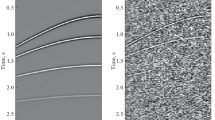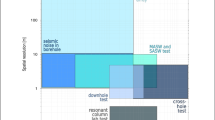Abstract
Accurate Q parameter is hard to be obtained, but there is great difference between Q measurements from different measurement methods in seismic physical modelling. The influence factors, stability and accuracy of different methods are analyzed through standard sample experiment and the seismic physical modelling. Based on this, we proposed an improved method for improving accuracy of pulse transmission method, in which the samples with similar acoustic properties to the test sample are selected as the reference samples. We assess the stability and accuracy of the pulse transmission, pulse transmission insertion, and reflection wave methods for obtaining the quality factor Q using standard and reference samples and seismic physical modeling. The results suggest that the Q-values obtained by the pulse transmission method are strongly affected by diffraction and the error is 50% or greater, whereas the relative error of the improved pulse transmission method is about 10%. By using a theoretical diffraction correction method and the improved measurement method, the differences among the Q-measuring methods can be limited to within 10%.
Similar content being viewed by others
References
Bass, R., 1958, Diffraction Effects in the Ultrasonic Field of a Piston Source: Journal of the Acoustical Society of America, 30(7), 602–605.
Bath, M., 1974, Spectral Analysis in Geophysics: New York: Elsevier. 25–73.
Best, A. I., Sothcott J., Mccann C., 2007, A laboratory study of seismic velocity and attenuation anisotropy in near-surface sedimentary rocks: Geophysical Prospecting, 55(5), 609–625.
Breazeale, M. A., Cantrell, J. H., Heyman, J S., 1981, Ultrasonic Wave Velocity and Attenuation Measurements: Methods of Experimental Physics, 19(08), 67–135.
Chen, S.Q., Li, X.Y., and Wang, S.X., 2012 The analysis of frequency-dependent characteristics for fluid detection: a physical model experiment: Applied Geophysics, 9(2), 121–122.
Ekanem, A. M., Wei, J. X., Li, X. Y., et al., 2013, P–wave attenuation anisotropy in fractured media: A seismic physical modelling study: Geophysical Prospecting, 61(s1), 420–433.
He, T., Zou, C.C., Pei, F. G., Ren, K.Y., Kong F.D., and Shi G., 2010, Laboratory study of fluid viscosity induced ultrasonic velocity dispersion in reservoir sandstones: Applied Geophysics, 07(2), 114–126.
Mccann, C., and Sothcott, J., 1992, Laboratory measurements of the seismic properties of sedimentary rocks: Geological Society of London, 65(1), 285–297.
Papadakis, E. P., 1966, Ultrasonic Diffraction Loss and Phase Change in Anisotropic Materials: Journal of the Acoustical Society of America, 40(4), 863–876.
Papadakis, E. P., 1968, Buffer-Rod System for Ultrasonic Attenuation Measurements: Journal of the Acoustical Society of America, 44(5), 1437–1441.
Papadakis, E. P., 1972, Ultrasonic Diffraction Loss and Phase Change for Broad-Band Pulses: Journal of the Acoustical Society of America, 52(3), 847–849.
Papadakis, E. P., Fowler, K. A., and Lynnworth, L. C., 1973, Ultrasonic attenuation by spectrum analysis of pulses in buffer rods: Method and diffraction corrections: Journal of the Acoustical Society of America, 53(5), 1336–1343.
Schreiber, E., Anderson, O. L., Soga, N., et al., 1975, Elastic Constants and Their Measurement: Journal of Applied Mechanics, 42(3), 747–748.
Seki, H., Granato, A., Truell, R., 1956, Diffraction Effects in the Ultrasonic Field of a Piston Source and Their Importance in the Accurate Measurement of Attenuation: Journal of the Acoustical Society of America, 28(2), 230–238.
Tang, X. M., Toksöz, M. N., Cheng, C. H., 1990, Elastic wave radiation and diffraction of a piston source: Journal of the Acoustical Society of America, 87(5), 1894–1902.
Toksöz, M. N., Johnston, D. H., Timur, A., 1979, Attenuation of seismic waves in dry and saturated rocks: I. Laboratory measurements. Geophysics, 44(4), 681–690.
Wei, J. X., and Di, B. R., 2006, Properties of materials forming the 3-D geological model in seismic physical model: Geophysical Prospecting for Petroleum, 45(6), 586–590.
Winkler, K. W., and Plona T. J., 1982, Technique for measuring ultrasonic velocity and attenuation spectra in rocks under pressure: Journal of Geophysical Research Atmospheres, 87(B13), 10776–10780.
Xing, G., Yang, P., and He, L., 2013, Estimation of diffraction effect in ultrasonic attenuation by through–transmission substitution technique: Ultrasonics, 53(4), 825–830.
Xu, W., and Kaufman, J. J., 1993, Diffraction correction methods for insertion ultrasound attenuation estimation: IEEE Transactions on Biomedical Engineering, 40(6), 563–570.
Zemanek, J., and Rudnick I., 1961, Attenuation and Dispersion of Elastic Waves in a Cylindrical Bar: Journal of the Acoustical Society of America, 33(10), 1283–1288.
Zhu, W., and Shan, R., 2016, Digital core based transmitted ultrasonic wave simulation and velocity accuracy analysis: Applied Geophysics, 13(2), 375–381.
Acknowledgments
We thank Professors Genyang Tang and Sanyi Yuan for comments and suggestions.
Author information
Authors and Affiliations
Corresponding author
Additional information
This study was supported by the National Nature Science Foundation of China (No.41474112) and the National Science and Technology Major Project (No.2017ZX05005-004).
The Gao Feng graduated from a bachelor's degree in geophysics from Shandong University of Science and Technology (2011). He received a MS in exploration geophysics from China University of Mining & Technology-Beijing (2014). Currently he is studying his Ph.D. student in the College of Geophysics and Information Engineering, China University of Petroleum (Beijing). His main research interests are seismic attenuation and the physical modelling.
Rights and permissions
About this article
Cite this article
Gao, F., Wei, JX. & Di, BR. Seismic physical modeling and quality factor. Appl. Geophys. 15, 46–56 (2018). https://doi.org/10.1007/s11770-018-0664-y
Received:
Revised:
Published:
Issue Date:
DOI: https://doi.org/10.1007/s11770-018-0664-y




